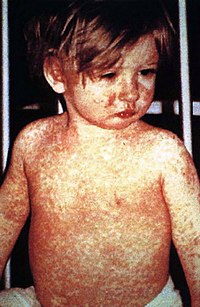
Photo from wikipedia
Abstract Background Pediatric international travelers account for nearly half of measles importations in the United States. Over one third of pediatric international travelers depart the United States without the recommended… Click to show full abstract
Abstract Background Pediatric international travelers account for nearly half of measles importations in the United States. Over one third of pediatric international travelers depart the United States without the recommended measles-mumps-rubella (MMR) vaccinations: 2 doses for travelers ≥12 months and 1 dose for travelers 6 to <12 months. Methods We developed a model to compare 2 strategies among a simulated cohort of international travelers (6 months to <6 years): (1) No pretravel health encounter (PHE): travelers depart with baseline MMR vaccination status; (2) PHE: MMR-eligible travelers are offered vaccination. All pediatric travelers experience a destination-specific risk of measles exposure (mean, 30 exposures/million travelers). If exposed to measles, travelers’ age and MMR vaccination status determine the risk of infection (range, 3%-90%). We included costs of medical care, contact tracing, and lost wages from the societal perspective. We varied inputs in sensitivity analyses. Model outcomes included projected measles cases, costs, and incremental cost-effectiveness ratios ($/quality-adjusted life year [QALY], cost-effectiveness threshold ≤$100 000/QALY). Results Compared with no PHE, PHE would avert 57 measles cases at $9.2 million/QALY among infant travelers and 7 measles cases at $15.0 million/QALY among preschool-aged travelers. Clinical benefits of PHE would be greatest for infants but cost-effective only for travelers to destinations with higher risk for measles exposure (ie, ≥160 exposures/million travelers) or if more US-acquired cases resulted from an infected traveler, such as in communities with limited MMR coverage. Conclusions Pretravel MMR vaccination provides the greatest clinical benefit for infant travelers and can be cost-effective before travel to destinations with high risk for measles exposure or from communities with low MMR vaccination coverage.
Journal Title: Journal of the Pediatric Infectious Diseases Society
Year Published: 2022
Link to full text (if available)
Share on Social Media: Sign Up to like & get
recommendations!